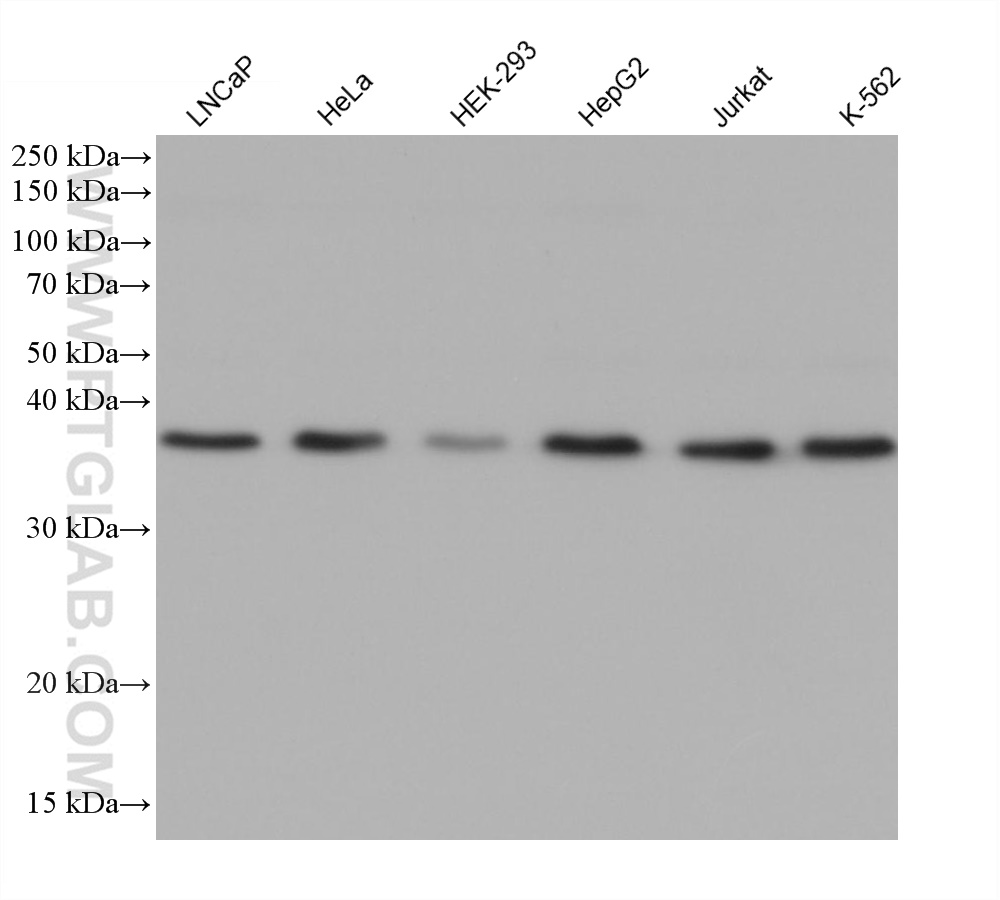验证数据展示
经过测试的应用
| Positive WB detected in | LNCaP cells, HeLa cells, HEK-293 cells, HepG2 cells, Jurkat cells, K-562 cells |
推荐稀释比
| 应用 | 推荐稀释比 |
|---|---|
| Western Blot (WB) | WB : 1:5000-1:50000 |
| It is recommended that this reagent should be titrated in each testing system to obtain optimal results. | |
| Sample-dependent, Check data in validation data gallery. | |
产品信息
68492-1-Ig targets CIAPIN1 in WB, ELISA applications and shows reactivity with Human samples.
| 经测试应用 | WB, ELISA Application Description |
| 经测试反应性 | Human |
| 免疫原 |
CatNo: Ag33193 Product name: Recombinant human CIAPIN1 protein Source: e coli.-derived, PET28a Tag: 6*His Domain: 1-312 aa of BC024196 Sequence: MADFGISAGQFVAVVWDKSSPVEALKGLVDKLQALTGNEGRVSVENIKQLLQSAHKESSFDIILSGLVPGSTTLHSAEILAEIARILRPGGCLFLKEPVETAVDNNSKVKTASKLCSALTLSGLVEVKELQREPLTPEEVQSVREHLGHESDNLLFVQITGKKPNFEVGSSRQLKLSITKKSSPSVKPAVDPAAAKLWTLSANDMEDDSMDLIDSDELLDPEDLKKPDPASLRAASCGEGKKRKACKNCTCGLAEELEKEKSREQMSSQPKSACGNCYLGDAFRCASCPYLGMPAFKPGEKVLLSDSNLHDA 种属同源性预测 |
| 宿主/亚型 | Mouse / IgG1 |
| 抗体类别 | Monoclonal |
| 产品类型 | Antibody |
| 全称 | cytokine induced apoptosis inhibitor 1 |
| 别名 | 2810413N20Rik, Anamorsin, CIAPIN1, DRE2, PRO0915 |
| 计算分子量 | 312 aa, 34 kDa |
| 观测分子量 | 37 kDa |
| GenBank蛋白编号 | BC024196 |
| 基因名称 | CIAPIN1 |
| Gene ID (NCBI) | 57019 |
| RRID | AB_3085203 |
| 偶联类型 | Unconjugated |
| 形式 | Liquid |
| 纯化方式 | Protein G purification |
| UNIPROT ID | Q6FI81 |
| 储存缓冲液 | PBS with 0.02% sodium azide and 50% glycerol, pH 7.3. |
| 储存条件 | Store at -20°C. Stable for one year after shipment. Aliquoting is unnecessary for -20oC storage. |
背景介绍
The cytokine-induced anti-apoptotic molecule (CIAPIN1, or DRE2) had been found to be a differentially-expressed gene involved in a variety of cancers, and it was also considered as a candidate tumor suppressor gene in gastric cancer, renal cancer and liver cancer. CIAPIN1 plays an important role in the differentiation of colorectal cancer (CRC) cells, and the differential expression of CIAPIN1 in CRC was closely related to prognosis. CIAPIN1 might play an important role in esophageal carcinogenesis, and it could be considered as a valuable prognostic indicator in esophageal squamous cell carcinoma (ESCC).
实验方案
| Product Specific Protocols | |
|---|---|
| WB protocol for CIAPIN1 antibody 68492-1-Ig | Download protocol |
| Standard Protocols | |
|---|---|
| Click here to view our Standard Protocols |


